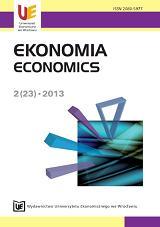Geneza i rola gospodarstw rodzinnych w rolnictwie polskim
Genesis and the role of family farmsin polish agriculture
Author(s): Franciszek KapustaSubject(s): Economy
Published by: Wydawnictwo Uniwersytetu Ekonomicznego we Wrocławiu
Keywords: origin; family farm; area; non-agricultural; transformation; development
Summary/Abstract: The concept of the family farm operates in everyday speech since the emancipation of peasants. Its definition introduces first the Act of 11 April 2003 on shaping of the agricultural system, which provides that a family farm is an entity that is maintained by an individual farmer and the total area does not exceed 300 hectares of agricultural land. Family farms in Poland have come a long and deep transformation under the influence of political, economic and demographic factors. The aim of this paper is to present the origins and role of family farms with particular emphasis on years 2003-2009, i.e. in times of the European Union. The development is based on literature research and statistical information. The collected material was developed and interpreted by a number of methods, and in particular: a compa- rative method in the form of horizontal and vertical, and statistical analysis. Family farms in agriculture in Poland emerged as a result of the emancipation of peasants in the feudal period of transition to a capitalist economy. This process took place in the period of the partitions, and on the principles established by the partitioning powers. Enfranchisement began early in the Prussian partition (1808), followed by Galicia (1848), and by the Polish Kingdom (1863). After World War I Polish parliament voted three times a law on agrarian reform: 1919, 1920 and 1925, resulting in the further shift of land from private to peasant estates and the emergence of new family farms. Further development of family farms followed after World War II as a result of the Land Reform decree of 6 September 1944, and Land Use of the Recovered Territories of 13 November 1945. Overall it can be stated that until 1949 the shaping of agricultural system took place and the foundations of the agrarian structure in Poland followed. Year 1950 as a result of the Census provides us with information about the state of family farms to which we can make a comparison of their further development. Subsequent changes in family farms happened as a result of non-uniform state policy towards them; decline in years 1950-1956, the recovery in years 1956-1960, the weakening economy until 1970, and then the reconstruction of these households until 1989. Large changes in the functioning of these farms occurred at the beginning of the nineties of the twentieth century as a result of: the transition from a centrally planned economy to a market economy, solution of State Farms and the flow of resources to family farms and reduction of the range of co-operatives in agriculture.
Journal: Ekonomia
- Issue Year: 2013
- Issue No: 23
- Page Range: 151-167
- Page Count: 17
- Language: Polish

